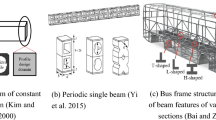Abstract
We present a method for obtaining conjugate, conjoined shapes and tilings in the context of the design of structures using topology optimization. Optimal material distribution is achieved in topology optimization by setting up a selection field in the design domain to determine the presence/absence of material there. We generalize this approach in this paper by presenting a paradigm in which the material left out by the selection field is also utilised. We obtain conjugate shapes when the region chosen and the region left-out are solutions for two problems, each with a different functionality. On the other hand, if the left-out region is connected to the selected region in some pre-determined fashion for achieving a single functionality, then we get conjoined shapes. The utilization of the left-out material, gives the notion of material economy in both cases. Thus, material wastage is avoided in the practical realization of these designs using many manufacturing techniques. This is in contrast to the wastage of left-out material during manufacture of traditional topology-optimized designs. We illustrate such shapes in the case of stiff structures and compliant mechanisms. When such designs are suitably made on domains of the unit cell of a tiling, this leads to the formation of new tilings which are functionally useful. Such shapes are not only useful for their functionality and economy of material and manufacturing, but also for their aesthetic value.






















Similar content being viewed by others
References
Alwan A, Ananthasuresh GK (2006) Coupled electrostatic-elastic analysis for topology optimization using material interpolation. In: International MEMS conference, Journal of Physics: conference series, vol 34, pp 264–270
Balaji G, Biradar P, Saikrishna C, Venkata Ramaiah K, Bhaumik S, Haruray A, Ananthasuresh GK (2008) An SMA-actuated, compliant mechanism-based pipe-crawler. In: International conference on smart materials, structures, and systems
Bendsøe MP, Kikuchi N (1988) Generating optimal topologies in structural design using a homogenization method. Comput Methods Appl Mech Eng 71:197–224
Bendsøe MP, Sigmund O (2003) Topology optimization—theory methods and applications, vol 4, 2nd edn. Springer, Berlin
Borrvall T, Petersson J (2003) Topology optimization of fluids in stokes flow. Int J Numer Methods Fluids 41:77–107
Deepak RS, Mana D, Sahu D, Ananthasuresh GK et al (2009) A comparative study of the formulations and benchmark problems for topology optimization of compliant mechanisms. J Mech Robot 1:011003
Diaz A, Bendsøe MP (1992) Shape optimization of structures for multiple loading conditions using a homogenization method. Struct Optim 4:17–22
Evgrafov A, Pingen G, Maute K et al (2006) Topology optimization of fluid problems by the lattice boltzmann method. In: IUTAM symposium on topological design optimization of structures, machines and materials: status and perspectives. Springer, pp 559–568
Knowles PR (1991) Castellated beams. In: Structural and building board, vol 90, pp 521–536
Limaye P, Meenakshi Sundaram M, Ananthasuresh GK (2009) Optimal conjugate topologies on a single domain. In: 8th world congress on structural optimization, Lisbon, Portugal
Pedersen CG, Lund JJ, Damkilde L, Kristensen AS et al (2006) Topology optimization—improved checker-board filtering with sharp contours. In: 19th Nordic seminar on computational mechanics, p 4
Raulli M, Maute K (2005) Topology optimization of electrostatically actuated microsystems. Struct Multidisc Optim 30(5):342–359
Roach G, Howell L (2002) Evaluation and comparison of alternative compliant overrunning clutch designs. J Mech Des 124:485–491
Saxena A, Ananthasuresh GK (2000) On an optimal property of compliant topologies. Struct Multidisc Optim 19:36–49
Sigmund O (2001) Topology optimization methods with applications in mechanisms, MEMS and material design. Solid Mechanics, Department of Mechanical Engineering, Technical University of Denmark
Sigmund O (2007) Morphology-based black and white filters for topology optimization. Struct Multidisc Optim 33:401–424
Sigmund O, Clausen PM (2007) Topology optimization using a mixed formulation: an alternative way to solve pressure load problems. Comput Methods Appl Mech Eng 196:1874–1889
Svanberg K (1987) The method of moving asymptotes—a new method for structural optimization. Int J Numer Methods Eng 24:359–373
Wang M, Wang S (2005) Bilateral filtering for structural topology optimization. Int J Numer Methods Eng 63(13):1911–1938
Yin L, Ananthasuresh GK (2001) Topology optimization of compliant mechanisms with multiple materials using a peak function material interpolation scheme. Struct Multidisc Optim 23:49–62
Yin L, Ananthasuresh GK (2003) Design of distributed compliant mechanisms. Mech Based Des Struct Mach 31(2):151–179
Yoon GH, Sigmund O (2008) A monolithic approach for topology optimization of electrostatically actuated devices. Comput Methods Appl Mech Eng 197:4062–4075
Acknowledgements
The authors would like to thank G. Ramu and M.S. Deepika for his help in manufacturing the prototypes. Anonymous reviewers’ comments on improving the organisation of the paper are gratefully acknowledged.
Author information
Authors and Affiliations
Corresponding author
Additional information
An enhanced version of a brief conference paper presented at the World Conference of Structural and Multi-disciplinary Optimization 2009, titled ‘Optimal conjugate topologies on a single domain’, by Padmanabh Limaye, M. Meenakshi Sundaram, and G. K. Ananthasuresh.
Rights and permissions
About this article
Cite this article
Sundaram, M.M., Limaye, P. & Ananthasuresh, G.K. Design of conjugate, conjoined shapes and tilings using topology optimization. Struct Multidisc Optim 45, 65–81 (2012). https://doi.org/10.1007/s00158-011-0657-4
Received:
Revised:
Accepted:
Published:
Issue Date:
DOI: https://doi.org/10.1007/s00158-011-0657-4




